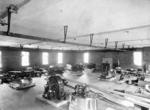Editor’s note: This is the conclusion of the story, “Pioneer pluck in Hunter Creek,” that ran in the Sunday Aspen Daily News about the importance of the Hunter Creek Valley to Aspen’s history.

By 1885, Aspen endured its first housing crisis. “Rents are high and domestics are scarce and command good prices … every type of business appears to be crowded,” the Jan. 3, 1885, Rocky Mountain Sun reported. Miners averaged $3.50 a day and paid about $10 per week for room and board.
Such growth and prosperity needed a bigger water system for the mushrooming town and to charge fire hydrants. With water for the city already coming from Castle Creek, the 900-foot torrent of Hunter Creek that dramatically cascaded into town presented the solution.
Concurrent with their Cowenhoven Tunnel work, town titans H.P. Cowenhoven and D.R.C. Brown acquired city endorsement to pipe in Hunter Creek’s then-raging flow to their Aspen Water Company pipes throughout town, the Jan. 2, 1886, Aspen Times reported. With an elevation advantage over Castle Creek, Hunter water could push back Castle Creek water pressure in the town system, top off the Castle Creek reservoir — above today’s hospital — and supercharge water pressure to more fire hydrants about town.
By May of 1886, the wooden dam anchored in boulders several miles up Hunter and the reservoir there fed the town's water pipes. That water journeyed from the dam down a flume built with wood from Andy McFarlane’s Hunter mill to a wooden tank and into a pipeline under the Roaring Fork to connect with the water main on Mill Street. The May 22, 1886, Sun reported that McFarlane’s flume had a 9-million-gallon flow per day capacity, “sufficient to supply a city of 100,000.”
Many thought Hunter Creek’s lower mineral content was tastier than Castle Creek water. Dr. Teller — Pitkin County’s first county physician — assessed Hunter water, as reported in the Feb. 21, 1886, Times, “with small quantities of sulfuric acid acting as a tonic … the magnesium as a stimulant to the kidneys … and lime able to produce gravel in the bladder.”
Town washerwomen preferred “soft as rainwater” Hunter Creek for laundry, while Sanders Brewery, which ran a ditch from the creek to brew its beer, characterized the “Adam’s ale” from Hunter as granite filtered and “pure as Kentucky water” in its ads.
Once Hunter Creek was hooked up, Mondays and Tuesdays became “wash days,” when only Hunter water and not Castle Creek water flowed through town’s pipes. According to local historian Jim Markalunas, whose book “Aspen Memories” details valuable historical anecdotes over his life back to the 1930s, wash days continued on Mondays into the 1940s, until components of the Hunter Creek hydroelectric system all went to the national war effort for scrap steel.
Hunter powers electricity
Well before the mid-1960s when the controversial Frying Pan-Arkansas water diversion project skimmed off the native strength of Hunter Creek to the Front Range, the bountiful supply of Hunter Creek powered Aspen’s first electricity. A Sun snippet described the fall from the creek’s plateau into town as a “raging, deafening cataract” during runoff, often taking out bridges below.

The interior of the Hunter Creek power plant in 1900, showing the belt driven technology that powered the town of Aspen and mines, using the cascading Hunter Creek water that intersected with the Roaring Fork below.
By 1885, the first Aspen “Consumers Electric Light and Power Company” plant neared completion to tap that power at the base of the cascade, while the plant’s machinery was at the rail station in Granite, on the eastside of Independence Pass, the May 1, 1886, Sun said. Presumably, transport of the single 62-inch steel Pelton wheel (a wheel with circumferential cupped appurtenances pushed round by water flow) and two giant dynamos journeyed over the pass by wagon, since trains did not run into Aspen until 1887.
A few wrinkles remained. The April 1, 1888, Times reported that a cow had fallen into the upper Hunter Creek ditch and its carcass blocked the head gate into the pipe that sent water to the power company, temporarily stopping electricity to town.
Soon, that first Hunter Creek plant couldn’t power the multiplying mines and lighting in prosperous Aspen, and a larger one was built by 1889, which still stands as the former Aspen Art Museum on the Roaring Fork. That became the Roaring Fork Light & Power Company, which housed nine Pelton wheels pushed by 380 PSI of water pressure, or 500-plus horsepower, to expand service and provide “non-stop” electricity, the Jan. 1, 1889, Aspen Chronicle detailed.
Prior to the Pelton wheels, CEL&PC’s earlier iteration operated with wooden water wheels turning DC dynamos to a few electric lights. The first electric mining hoist in the world was at the Veterans Tunnel — located on today’s FIS Slalom Hill on Aspen Mountain — which the January Chronicle cited as starting on July 26, 1888. The Park-Regent, part of the contact lineup of mines across the way on Smuggler Mountain, ran a second electric hoist starting up on Oct. 1. Both ran 12 hours a day on Hunter Creek water.
Thus, in 1886, “the best little city in the Rockies,” as the papers often said, was independently positioned to have an endless water supply and its own hydro-powered electricity — the first west of the Mississippi — to propel its engine of commerce. Engineers from London and Japan journeyed to Aspen to study the innovative system.
Cowenhoven and Brown were members of the board in the evolving light and power company. Brown would go on to build Aspen’s third power plant under the Castle Creek bridge in 1893, which would operate until 1958, when Aspen lost its electrical generating independence and tapped the larger grid.
Hunter Creek legacy
After the Panic of 1893 and into the quiet years of the first half of the 20th century, when Aspen was still a backwater city known for timber and speculative mining ventures, the latter waned and ranching flourished. At the same time, a handful of working silver mines through the 1930s, content to meet demand at adjusted prices for lower-grade ore, championed an elusive mining resurgence.
Reaching far back into the wilderness, the Hunter valley served as Aspen’s backyard for hunting, fishing and horseback riding, while ranching there still supplied dairy, hay and sheep herding space. During that halcyon era when the ratio of people and recreationalists to wilderness didn’t challenge the vastness, nature not only tolerated a balance of land use in Hunter but reclaimed much of the land scarred by mining, sawmills and charcoal processing. The old Hunter Creek road provided free and easy access to all, when all were few.
The October 27, 1961, Times reported that Dub Tacker shot a bull and Orville Rusher a cow elk in Hunter, while Ken “KNCB” Moore faced a bear, but “the bear’s retreat was faster than Moore’s attack.”
But beginning in the 1960s, pressure on the valley escalated as the Frying Pan-Arkansas water diversion project eyed Hunter Creek’s flows. And in 1962, a California development company in talks with the Aspen chamber of commerce bought the 1,850 acre Lemeque ranch in Hunter to build a “vacation resort there,” the August 31, 1962 Times wrote.
A 1963 booklet at the Aspen Historical Society titled “Development Plan of Aspen-Hunter Valley,” by Victor Gruen Associates, connected to a famed Austrian architect who pioneered shopping malls in the United States, details the speculative Hunter complex with up to 700 building lots, a village, lake, lodge and ski area. Strong local opposition against the plan popularized the derogatory term “California developers,” which became the incipient rallying cry for resistance against big development in town.
In the early 1970s conservationists and backcountry enthusiasts secured congressional approval of the federal purchase of the Hunter valley floor from McCulloch Oil Company, averting a planned 1,200-house subdivision. In 1978, Pitkin County transferred Hunter territory and mining claims it had purchased to the Forest Service, which the USFS rolled into the 82,450-acre Hunter-Frying Pan Wilderness area.
In 1987, the McCloskey family bought a 70-acre parcel from Fritz Benedict at the edge of the National Forest boundary at the entrance to Hunter Creek and built a monumental house. This became one of a string of emblematic Pitkin County struggles to curb wilderness trophy homes on mining claims.
In league with other Red Mountain homeowners, the McCloskeys blocked public entry on the county road by their property. A 16-year litigation ensued, wherein Aspen’s old and young guard formed the “Friends of Hunter Creek,” finally securing public access in 2004 to Hunter Creek via a compromise route, after the U.S. District Court ruled in 1998 that the north and south branches of the Hunter Creek road were public based upon the county purchase in 1891 of commercial access.
In October of 2004, Friends of Hunter Creek, the county and private home owners signed onto the mediated Hunter Creek settlement, which perpetuates public access to Aspen’s backyard playground in the scenic valley northeast of town.
Tim Cooney is a freelance writer and retired Aspen Mountain ski patroller. Aspen Journalism is a local, nonprofit, investigative organization covering Aspen history in collaboration with the Aspen Daily News. For more, visit www.aspenjournalism.org.
"soft" - Google News
May 31, 2021 at 04:00PM
https://ift.tt/2ROAL8Z
‘Soft as rainwater,’ Hunter Creek reclaims itself - Aspen Daily News
"soft" - Google News
https://ift.tt/2QZtiPM
https://ift.tt/2KTtFc8
Bagikan Berita Ini














0 Response to "‘Soft as rainwater,’ Hunter Creek reclaims itself - Aspen Daily News"
Post a Comment